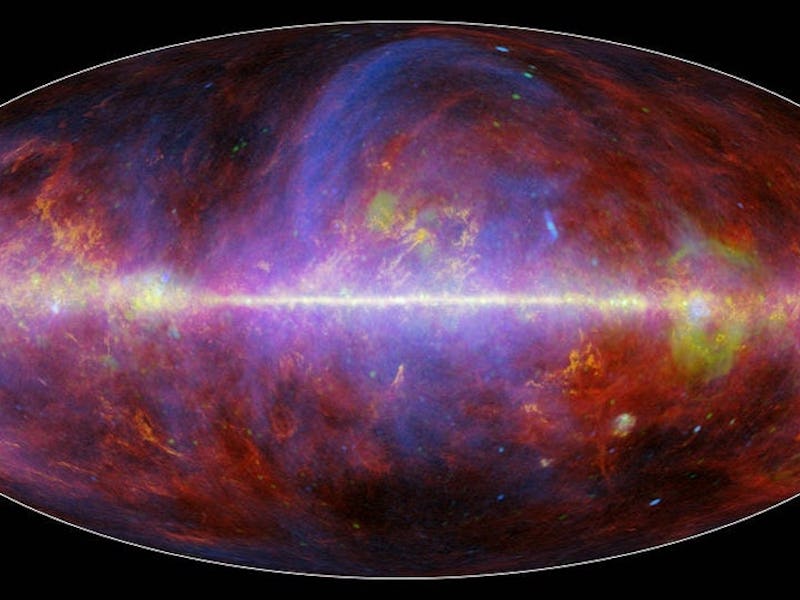There’s a mysterious barrier in the center of the Milky Way
Researchers found a dip in the otherwise uniform density of our galaxy’s cosmic rays.

At the center of our galaxy, enshrouded by molecular gas clouds, is a great barrier. Similarities to the plot of Star Trek V: The Final Frontier are purely coincidental.
Chinese researchers discovered the nonfictional barrier while studying cosmic rays, high-energy charged particles that travel through the universe at nearly the speed of light. A relatively uniform “sea” of this radiation suffuses our galaxy, scientists report in a paper published Tuesday in Nature Communications.
However, the study also found an area near the center of the Milky Way without these background cosmic rays, suggesting “the existence of a barrier that can effectively suppress the penetration of the particles from the cosmic-ray sea.”
Understanding what is generating the barrier could help scientists better understand how cosmic rays and galaxies behave (the god Sha Ka Ree is not under consideration).
What’s new— This examination of the cosmic rays near our galactic center revealed cosmic ray density dipped in the central molecular zone, an area of vast stellar clouds near the very heart of our galaxy, the Milky Way.
Since the density of cosmic rays was mostly constant in the surrounding regions, the researchers concluded the cosmic ray “sea” was lapping up against something, perhaps a powerful magnetic field, preventing the rays from penetrating.
But the study found our galaxy’s core doesn’t just ward off cosmic rays. It is possible that elements in the galactic core also accelerate cosmic rays through the galaxies. This study adds support to previous findings which suggest this.
What are cosmic rays?
Cosmic rays are primarily protons, the atomic nuclei of hydrogen atoms shorn of their electrons. They stem from supermassive black holes, galactic collisions, and other high energy, cataclysmic events. The particles that make up cosmic rays are often accelerated to velocities approaching the speed of light by the remnants of exploding stars, or other supermassive black holes.
The Milky Way’s magnetic field diffuses and distributes these cosmic rays into the background “sea” the researchers were studying.
This image zooms in the supermassive black hole Sagittarius A*. It is at the center of the Milky Way galaxy.
Past studies of the galactic core had also observed “fresh” cosmic rays overlaying the background sea of radiation, suggesting supernovae or the supermassive black hole at our galaxy center — Sagittarius A* — are whipping cosmic rays up to high speed.
It’s not clear exactly what is causing the acceleration of the cosmic rays at the galactic center. But the researchers note it could be related to the newfound barrier.
Sagittarius A* may produce a charged “galactic wind” that pushes against lower energy cosmic rays — a larger scale version of the interplay between our Sun’s solar wind and cosmic rays.
How the discovery was made — Past studies used the Fermi Large Area Telescope, or Fermi-LAT, to detect signs of cosmic ray acceleration in our galactic center.
But those studies didn’t factor in other observations of high-energy gamma rays, the most energetic form of light, which could result from the interaction of acerbated cosmic rays and the clouds of the central molecular zone.
So the researchers reanalyzed Fermi-LAT data originally recorded from August 4, 2008, to February 1, 2020, this time factoring in other observations, bolstering the evidence for cosmic ray accelerators, and discovering the cosmic ray barrier.
Why it matters— The sources of cosmic rays are not yet fully understood and are thought to be largely intergalactic, tiny signals from beyond anything like our Solar System.
A NASA illustration of a cosmic ray path.
A better understanding of cosmic ray behavior can help scientists better understand how the Milky Way functions and reveal new insight into the behavior of distant objects like blazars and colliding galaxies.
Practically speaking, given that both NASA and Elon Musk have goals of sending humans to Mars, better understanding how to divert DNA damaging cosmic rays is probably a good idea before you write up the constitution for your Martian colony.
What’s next— One limitation of the study, the researchers note, was the lack of detail in 3D modeling of gas and cosmic ray densities, so better modeling is an obvious follow-up.
“More precise three-dimensional gas models, particularly in the innermost region of the [galactic center], may further improve our understanding of the [cosmic ray] origin,” the scientists write.
Abstract: Cosmic rays are important probe of a number of fundamental physical problems such as the acceleration of high and very high energy particles in extreme astrophysical environments. The Galactic center is widely anticipated to be an important cosmic-ray source and the observations of some Imaging Atmospheric Cherenkov Telescopes did successfully reveal a component of TeV-PeV cosmic rays in the vicinity of the Galactic center. Here we report the identification of GeV-TeV cosmic rays in the central molecular zone with the γ-ray observations of the Fermi Large Area Telescope, whose spectrum and spatial gradient are consistent with that measured by the Imaging Atmospheric Cherenkov Telescopes but the corresponding cosmic-ray energy density is substantially lower than the so-called cosmic-ray sea component, suggesting the presence of a high energy particle accelerator at the Galactic center and the existence of a barrier that can effectively suppress the penetration of the particles from the cosmic-ray sea to the central molecular zone.